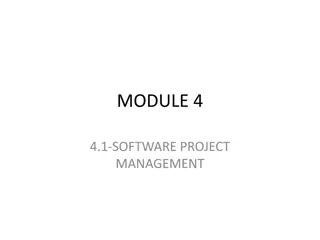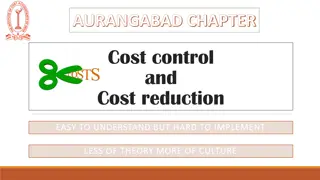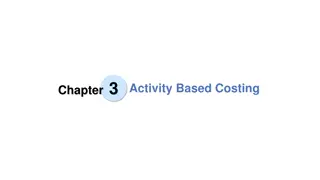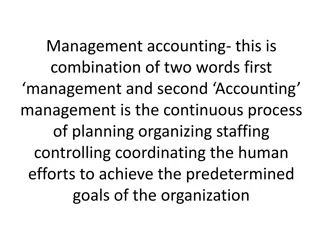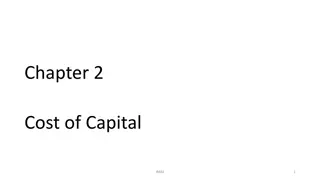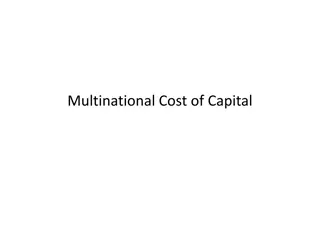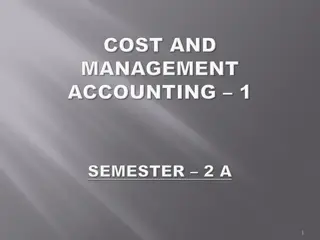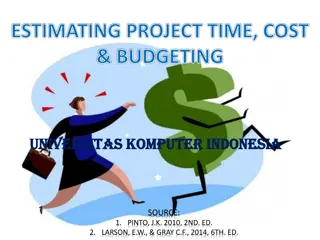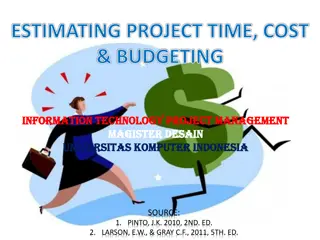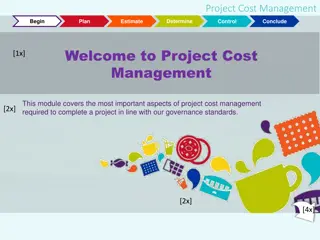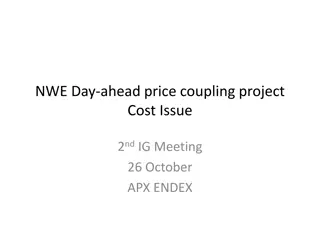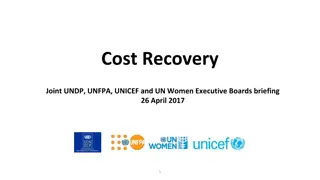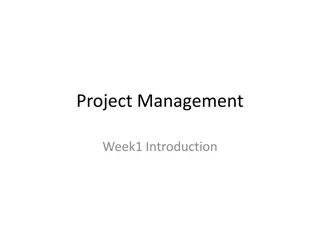Essential Project Cost Management Techniques
Explore the key aspects of project cost management, including budget planning, cost estimation, and stakeholder management. Learn about the types of project costs, budget considerations, and cost control mechanisms. Discover the foundational role of the Work Breakdown Structure (WBS) and work estimates in project planning. Enhance your understanding of cost classifications and sources while delving into effective budgeting strategies and risk management practices.
Download Presentation

Please find below an Image/Link to download the presentation.
The content on the website is provided AS IS for your information and personal use only. It may not be sold, licensed, or shared on other websites without obtaining consent from the author. Download presentation by click this link. If you encounter any issues during the download, it is possible that the publisher has removed the file from their server.
E N D
Presentation Transcript
4. Planning a Project 4. Planning a Project 1. Stakeholder Management 2. Project Scheduling 3. Budget Planning 4. Risk Management 2 2
Budget Planning Budget Planning 3
Learning Objectives Learning Objectives After completing this chapter, you should be able to: Understand and recognise the difference in the various types of common project costs Apply common forms of cost estimation for project work Understand the uses of activity-based budgeting and time-phased budgets for cost estimation and control Recognise the appropriateness of applying contingency funds for cost estimation 4
WBS and Work Estimates WBS and Work Estimates Source: Horine (2013). Figure: The foundational role the WBS and work estimates play in the overall planning process 5
Cost Management Cost Management Cost management Cost management has been defined to encompass data collection, cost accounting, and cost control Cost accounting Cost accounting and cost control cost control serve as the chief mechanisms for identifying and maintaining control over project costs Cost estimation Cost estimation processes create a reasonable budget baseline for the project 6
Sources and Types of Project Cost Sources and Types of Project Cost Sources: Sources: Types: Types: Labour Direct vs. Indirect Materials Recurring Vs. Nonrecurring Subcontractors Fixed Vs. Variable Equipment & Facilities Normal Vs. Expedited Travel 7
Budget Costs to Consider Budget Costs to Consider Figure: The budget costs to consider. Source: Horine (2013). 8
Cost Classifications Cost Classifications Type Frequency Adjustment Schedule Costs Direct Indirect Recurring Non- recurring Fixed Variable Normal Expedited Salaries x x x x Office rent x x x x Material x x x x Contrac- tual penalties x x x x Source: based on Pinto (2015). 9 9
Cost Estimation Cost Estimation Ballpark (order of magnitude) 30% Comparative 15% Feasibility 10% Definitive 5% Source: Pinto (2015). 10
Problems with Cost Estimation Problems with Cost Estimation Low initial estimates Unexpected technical difficulties Lack of definition Specification changes External factors Source: Pinto (2015). 11
Creating a Project Budget Creating a Project Budget WBS Project Plan The budget is a plan that identifies the resources, goals, and schedule that allows a firm to achieve those goals. Scheduling Budgeting Budgeting Top-down Bottom-up Activity-Based Costing (ABC) Source: Pinto (2015). 12
Activity Activity- -Based Costing Based Costing Projects use activities & activities use resources 1. 1. Assign costs Assign costs to activities that use resources 2. 2. Identify cost drivers Identify cost drivers associated with this activity 3. 3. Compute a cost rate Compute a cost rate per cost driver unit or transaction 4. 4. Multiply Multiply the cost driver rate times rate times the volume the project volume of cost driver units used by Source: Pinto (2015). 13
Sample Project Budget Sample Project Budget Activity Direct Cost Overhead Total Costs 1.3 Feasability study 300 60 360 2.1 Catering 2500 500 3000 2.2 Music 500 100 600 3.2 Flyers and Posters 300 30 330 Social media adds 300 30 330 14 14
Sample Budget Tracking Planned and Actual Sample Budget Tracking Planned and Actual Activity Costs Activity Costs Activity Planned Actual Variance 1.3 Feasability study 300 400 -100 2.1 Catering 2500 2500 0 2.2 Music 500 550 -50 3.2 Flyers and Posters 300 250 +50 Social media adds 300 300 0 15
Example of a Time Example of a Time- -Phased Budget Phased Budget Activity January February March April Total by activity 1.3 Feasability study 300 300 2.1 Catering 1000 1500 2500 2.2 Music 500 500 3.2 Flyers and Posters 200 100 300 Social media adds 300 300 Monthly planned 300 500 1100 2000 Cumulative 300 800 1900 3900 16
Budget Contingencies Budget Contingencies The allocation of extra funds to cover uncertainties and improve the chance of finishing on time Contingencies are needed because: 1. Project scope may change 2. Murphy s Law is present 3. Cost estimation must anticipate interaction costs 4. Normal conditions are rarely encountered Source: Pinto (2015). 17
Quiz Quiz 1. A systems analyst is paid at the rate of $50/hour and will be needed for 40 hours. Her employer uses an overhead multiplier of 60% and does not factor in personal time. Her total labor cost should be billed at: a) $2,000 b) $3,200 c) $1,250 d) $4,500 18 18
Discussion Discussion Do the majority of projects have cost overruns or underruns? Overrun Examples: Sydney Opera House: more than 14 times over budget The Boeing Dreamliner : initial estimate was $6 billion vs. final cost of $32 billion Elbe Philharmonic Hall in Hamburg: Initial estimate was 77 million EUR 789 million EUR = 1024% Berlin Brandenburg Airport: initial estimate 1 billion EUR current plan: 6 billion EUR = 600% What are reasons for these frequent cost overruns? 19
Exercise: Active Plenum to Develop a Budget Exercise: Active Plenum to Develop a Budget Volunteer Team? - Team presents their project in short - 2 team members moderate the development of the budget on the board - Rest of the class provides input based on brainstorming and/or questions by the moderators 20
Homework Homework Develop a budget plan for your project in your team for next week Be aware of the different cost estimation approaches. Your budget should be as accurate as possible. Hence, you will need to invest some research and provide the sources in your budget plan. This is the fourth tool of your project plan 21
Additional Additional reading reading Ward, S., & Chapman, C. (2003). Transforming project risk management into project uncertainty management. International Journal of Project Management, 21(2), 97-105. 22
Summary Summary WBS, Time planning (schedule) and Budget planning are related and depend on each other. The budget is a plan that identifies the resources, goals, and schedule that allows a firm to achieve those goals Different cost categories need to be considered when establishing a project budget The allocation of extra funds to cover uncertainties and improve the chance of finishing on time 23 23
Learning Objectives Learning Objectives After completing this chapter, you should be able to: Understand and recognise the difference in the various types of common project costs Apply common forms of cost estimation for project work Understand the uses of activity-based budgeting and time-phased budgets for cost estimation and control Recognise the appropriateness of applying contingency funds for cost estimation 24
References References Horine, Greg (2013): Absolute Beginner s Guide to Project Management, Que Sams/Pearson Education, 3rded. Pinto, J. K. (2015): Project management. Achieving competitive advantage, Pearson Education, Harlow, Essex, 4thed. Project Management Institute (2013): A Guide to the Project Management Body of Knowledge: PMBOK(R) Guide, Project Management Institute; 5thed. 25


